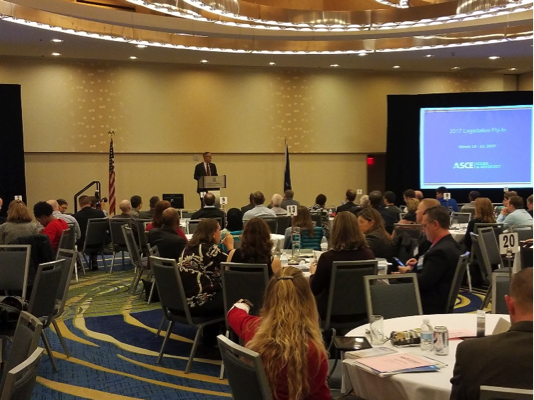By Gregory Scott, P.E., Government Relations Committee Chair
 Every spring, ASCE holds its Legislative Fly-In Program in Washington, DC, an intensive two-day program that provides participants with an inside look at the public policy process. On March 15th, while Winter Storm Stella wreaking havoc along much of the Northeast, over 200 ASCE Members representing 49 different states attended the 2017 American Society of Civil Engineers (ASCE) Legislative Fly-In. Many of the attendees were impacted by the storm but still found a way to DC, a testament to their passion for advocacy concerning what they know best.
Every spring, ASCE holds its Legislative Fly-In Program in Washington, DC, an intensive two-day program that provides participants with an inside look at the public policy process. On March 15th, while Winter Storm Stella wreaking havoc along much of the Northeast, over 200 ASCE Members representing 49 different states attended the 2017 American Society of Civil Engineers (ASCE) Legislative Fly-In. Many of the attendees were impacted by the storm but still found a way to DC, a testament to their passion for advocacy concerning what they know best.
The 2017 Legislative Fly-in program featured a day and a half of in-depth briefing sessions on the recently released 2017 Infrastructure Report Card, key legislative action in Congress, training on raising awareness and influencing elected leaders, networking with ASCE peers from across the country, a Younger Members Program, and tips on continuing relationships with elected officials after returning home. The program culminated in one-on-one meetings on Capitol Hill with members of Congress and their staff.
 The delegation from Pennsylvania included Mr. Jason Bowes, Central PA Section Government Relations Committee Chair and State Advocacy Captain; Mr. Jesse Gormley, Philadelphia Section Member; Mr. Joseph Natale, Philadelphia Section Member; Ms. Adrienne Nikolic, Philadelphia Section Member; Mr. John Caperilla, Lehigh Valley Section Government Relations Committee Chair and Mr. Gregory Scott, Pittsburgh Section Government Relations Committee Chair and Federal Advocacy Captain.
The delegation from Pennsylvania included Mr. Jason Bowes, Central PA Section Government Relations Committee Chair and State Advocacy Captain; Mr. Jesse Gormley, Philadelphia Section Member; Mr. Joseph Natale, Philadelphia Section Member; Ms. Adrienne Nikolic, Philadelphia Section Member; Mr. John Caperilla, Lehigh Valley Section Government Relations Committee Chair and Mr. Gregory Scott, Pittsburgh Section Government Relations Committee Chair and Federal Advocacy Captain.
The ASCE Government Relations staff scheduled meetings for each of the attendees with their Senate and Congressional Representatives within a short window on Wednesday afternoon. After being dropped off at Capitol Hill, Team Pennsylvania was off to the races to meet with both Senator’s and every team member’s Representative, as well as other Pennsylvania Representatives with a numerous ASCE member constituents. As the afternoon progressed, the group had an opportunity to engage in spirited and encouraging discussions with staff and Representatives from their home Districts as well as those identified as staff of ‘key’ Representatives who serve on infrastructure related and appropriations committees. The meetings lasted 15 to 30 minutes each, and a leave behind packet was given to the Legislator or staff member containing an overview of current key issues.
Most discussions began with a brief overview of the results and conclusions of the 2017 Infrastructure Report Card, which assigned America an overall grade of a D+, unchanged from 2013 and indicating the continuing needs for infrastructure investment. The Report highlighted that while the benefits were seen in seven categories where investments were made, three categories continued to fall short, and the remaining categories were holding steady, resulting in a lower of grades. The focus of all discussions was the need for consistent and sufficient funding, and the requirement of bold leadership from all.
One of the key items discussed were the FY17 and FY18 Spending/Appropriations Bills so that the FAST Act’s increased funding can take effect during this fiscal year and next. Congress passed the five-year surface transportation act in December 2015 and included an increase in funding to help improve the nation’s highways, bridges and transit systems. Most of the legislators were on board with the appropriations, however there seemed to be a lack of commitment without knowing what the new Administration’s Budget would contain. If a Continuing Resolution (CR) is passed, then Pennsylvania will miss out on over $115 million dollars for FY17 alone due to the lack of a Fast ACT Appropriations Bill ($1.58 billion up to $1.69 billion).
Additionally, the team discussed several water issues with the Representatives and staffers that included the Clean Water State Revolving Fund (SRF) and the Drinking Water State Revolving Fund. We asked the Representatives and Senators to reauthorize the Clean Water and Drinking Water SRF’s which hasn’t been done since 1990 and 1994. With most of America’s drinking water and wastewater infrastructure in need of repair and many areas dependent on these funds, the team advocated for both SRF’s to be tripled in appropriation from $1.39 Billion to $4.17 Billion for the Clean Water SRF and $863 million to $2.58 billion for the Drinking Water SRF in accordance with President Trump’s commitment to triple the SRF’s.
In 2016 after years of work the Water Infrastructure Investment for the Nation (WIIN) Act passed through Congress and was signed by the President. WIIN supported previous pieces of legislation but Congress has yet to appropriate the promised funding in any of them. In 2014, Congress reauthorized the National Dam Safety Program (NDSP) in the Water Resources Reform and Development Act (WRRDA) and established new High Hazard Dam Rehabilitation Program to provide grants to high hazard non-federal dam rehab repair or renewal. The NDSP program is authorized at $13.9 million a year until 2019 and the federal rehab program is authorized at $445 million over 10 years though neither have received any funding. In addition to dams, the team discussed the Levee Safety Program. With the WRDDA Act of 2014, Congress established a new levee program to promote consistent safety standards, create levee guideline, and provide funding assistance to the state for establishing participating levee safety programs. The program is authorized for $395 million dollars over 5 years however it has not received any appropriations for funding.
Lastly, with the push for tax reform and the discussion that is forthcoming including all tax exemptions, ASCE took the opportunity to remind legislators that tax-exempt municipal bonds are often relied upon for municipalities to complete infrastructure projects. The team discussed the importance of maintaining their tax-exempt status as just one of many ways to trim our infrastructure deficit.
 This year will be a busy one for the ASCE PA Government Relations team, with a State Infrastructure Day (Fly-In) scheduled for May 9th and efforts for the 2018 Report Card for Pennsylvania’s Infrastructure kicking off in the fall. If you are interested in participating in either of these events, please contact the Pittsburgh Section Government Relations Committee Chair, Greg Scott, at gscott@bucharthorn.com.
This year will be a busy one for the ASCE PA Government Relations team, with a State Infrastructure Day (Fly-In) scheduled for May 9th and efforts for the 2018 Report Card for Pennsylvania’s Infrastructure kicking off in the fall. If you are interested in participating in either of these events, please contact the Pittsburgh Section Government Relations Committee Chair, Greg Scott, at gscott@bucharthorn.com.
For more information concerning the ASCE National Fly-In please visit http://www.asce.org/legislative_fly-in/. Also, consider becoming a Key Contact at http://www.asce.org/keycontacts/ to stay engaged with advocating for infrastructure and public policy.
